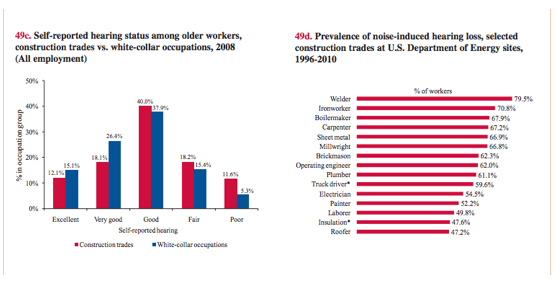DID YOU KNOW…
Construction No. 2 industry for hearing loss…
A study spanning a decade and incorporating hearing tests of more than 1.4 million American workers found that construction accounted for the second-highest prevalence of workers with a hearing impairment.(1) Every year, thousands of construction workers suffer hearing loss from excessive noise exposure on the job. Hearing loss impairs quality of life and increases the risk of injury – for instance, when a worker cannot hear approaching vehicles or warning signals.
Noise Exposure = Noise Induced Hearing Loss
Noise-induced hearing loss (NIHL) usually results from extended exposure to sound levels at or above 85 dBA. NIOSH suggests the maximum exposure for an 8 hour period without requiring hearing protection is 85 dBA.
Although NIHL is a well-known risk in construction, government data among construction workers are limited. Since employers have no obligation to test workers’ hearing (audiometric testing) in construction, even if employees experience noise levels at or above OSHA’s PEL[1], for hearing loss in construction is rarely recognized as an occupational disease. It is not surprising, therefore, that the numbers reported to the U.S. Bureau of Labor Statistics (BLS) show a very low rate of hearing loss, and for this reason hearing loss data for construction are not comparable with data for general industry.


Conducted by the Center for Disease Control and Prevention, the “Hearing Impairment Among Noise-Exposed Workers” study estimated the prevalence of hearing loss at six levels using hearing tests performed between 2003 and 2012. The study expressed the impact of hearing loss on quality of life as annual disability-adjusted life years (DALYs).
The mining sector had the highest prevalence of workers with hearing impairment, followed by the construction and manufacturing sectors. 17% of mining workers whose hearing tests were included had one of the six levels of impairment, while 3% had moderate or worse impairment. Construction was next with 16 % of workers testing positive for any impairment and, like mining, 3 % with moderate or worse. (3)
Manufacturing rounds out the top 3 with 14 % and 2%, respectively.
The CDC estimates that mining and construction workers lost 3.45 and 3.09 healthy years per 1,000 workers, respectively, due to their occupation. This statistic is actually quite shocking; imagine losing 3 years of your life.
The CDC notes, “Current noise regulations do not require audiometric testing for construction workers. Without testing to identify workers losing their hearing, intervention might be delayed or might not occur.” Because of that, the CDC stresses the importance of proper hearing loss prevention through earplugs and other methods of protection on construction sites.
With approximately 22 million U.S. workers exposed to hazardous occupational noise, hearing loss is the third most common chronic physical condition in the U.S. and is the most common work related illness among American workers. Being the third most common chronic condition, one would think that standards to prevent hearing loss would be stricter.
Facts and Statistics… DID YOU KNOW!
- Four million workers go to work each day in damaging noise. Ten million people in the U.S. have a noise-related hearing loss. Twenty-two million workers are exposed to potentially damaging noise each year.
- In 2007, approximately 23,000 cases were reported of occupational hearing loss that was great enough to cause hearing impairment.
Reported cases of hearing loss accounted for 14% of occupational illness in 2007. - In 2007, approximately 82% of the cases involving occupational hearing loss were reported among workers in the manufacturing sector.
- There are an estimated 16 million people working in the Manufacturing Sector, which accounts for approximately 13% of the U.S. workforce. According to the Bureau of Labor Statistics, occupational hearing loss is the most commonly recorded occupational illness in manufacturing (17,700 cases out of 59,100 cases), accounting for 1 in 9 recordable illnesses. More than 72% of these occur among workers in Manufacturing. These numbers are particularly disturbing considering that a person’s hearing loss must be determined to be work-related and the hearing loss must be severe enough that the worker has become hearing impaired, in order to be OSHA-recordable. Many more workers would have measurable occupational hearing loss but would not yet have become hearing impaired.
This blog is based on a research paper by:
Masterson EA, Bushnell PT, Themann CL, Morata TC. Hearing Impairment Among Noise-Exposed Workers — United States, 2003–2012. MMWR Morb Mortal Wkly Rep 2016;65:389–394. DOI: http://dx.doi.org/10.15585/mmwr.mm6515a2 (http://dx.doi.org/10.15585/mmwr.mm6515a2
[1] http://www.cpwr.com/sites/default/files/publications/CB%20page%2049.pdf
[2] Permitted Exposure Limit
[3] http://www.cpwr.com/sites/default/files/publications/CB%20page%2049.pdf

There should be more awareness of the potential risks of developing NIHL for those working in the construction industry. It is quite unpleasant that there has been no long-term intervention. No testing and the equipment might not be enough to protect from the noise. Thanks for sharing this!